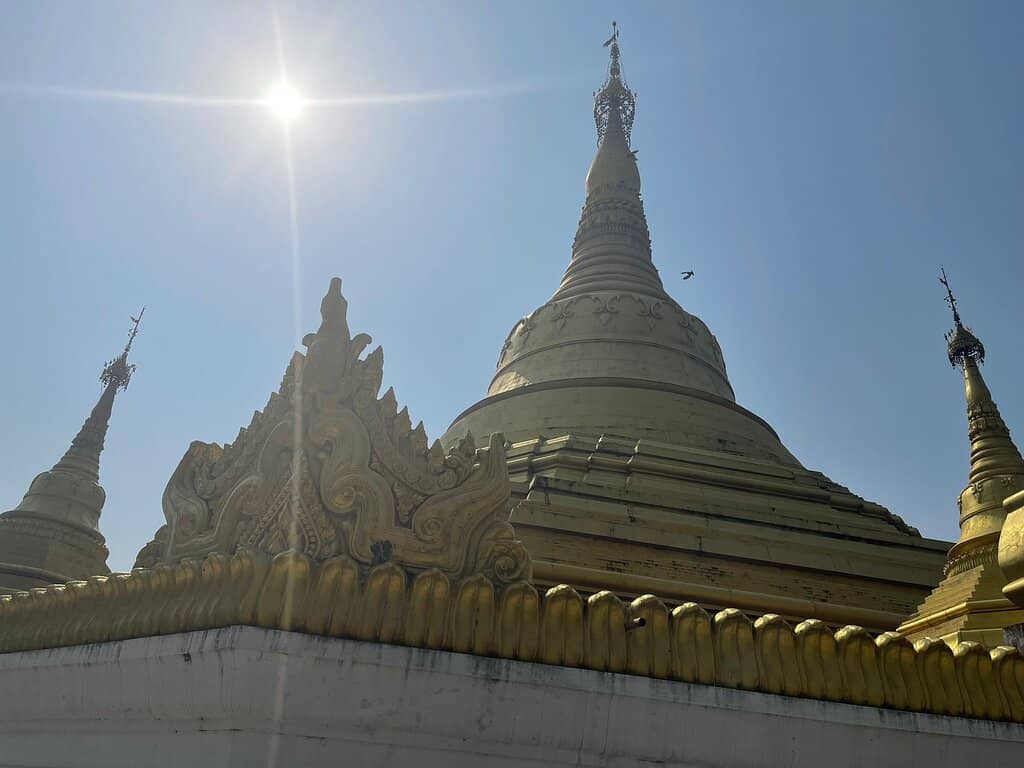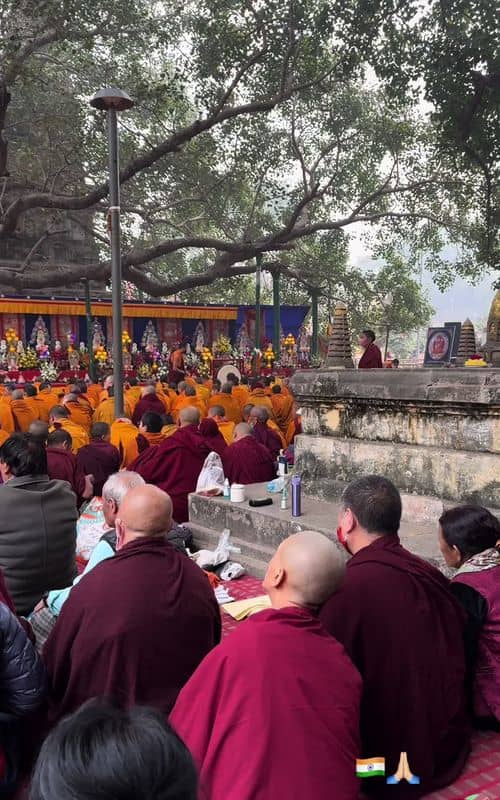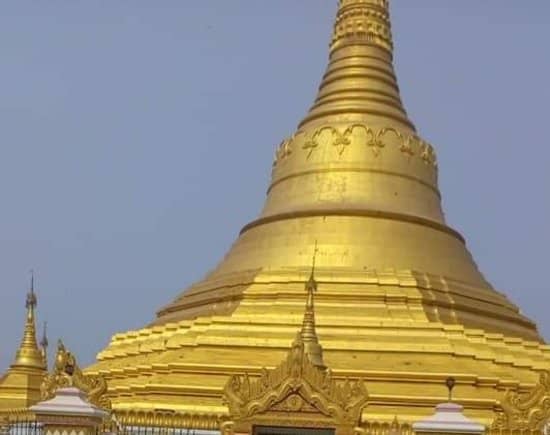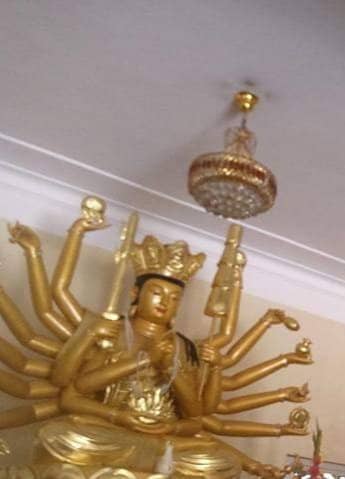
Japanese Temple Bodhgaya
Experience profound peace at Bodhgaya's Japanese Temple, a serene sanctuary with stunning traditional architecture and a tranquil Buddha statue.

Highlights
Must-see attractions

Social
From TikTok & Reddit
Best Time
Experience true serenity

Japanese Temple Bodhgaya
Best Time
Experience true serenity

Highlights
Must-see attractions
Experience profound peace at Bodhgaya's Japanese Temple, a serene sanctuary with stunning traditional architecture and a tranquil Buddha statue.
"The temple feels like you are in Japan, offering a beautiful and peaceful spiritual experience."

🎯 Arrive Before 11 AM
Beat the crowds and soak in the peaceful ambiance.
🚗 Hire a Local Auto
Efficiently visit multiple temples with a local guide.

Highlights
Discover the most iconic attractions and experiences

Traditional Japanese Architecture
Temple Grounds
Admire pagoda roofs, intricate woodwork, and the serene Buddha statue. It feels like stepping into Japan.

Peaceful Prayer Hall
Inside the Temple
Experience profound tranquility and meditate in the presence of a serene Buddha statue.

Zen & Pure Land Traditions
Temple Complex
Witness the embodiment of Japanese Buddhist spirit, offering a unique spiritual experience.
Plans like a pro.
Thinks like you
Planning Your Visit
Timing is Key for Tranquility
Getting There & Around
Best Times
Insider Tips
from TikTok, Instagram & Reddit
🎯 Arrive Before 11 AM
Beat the crowds and soak in the peaceful ambiance.
🚗 Hire a Local Auto
Efficiently visit multiple temples with a local guide.
🧘♀️ Meditate in Peace
The serene environment is perfect for quiet contemplation.
⏰ Check Temple Hours
It closes for a break between 12 PM and 2 PM.
Tips
from all over the internet
🎯 Arrive Before 11 AM
Beat the crowds and soak in the peaceful ambiance.
🚗 Hire a Local Auto
Efficiently visit multiple temples with a local guide.
🧘♀️ Meditate in Peace
The serene environment is perfect for quiet contemplation.
⏰ Check Temple Hours
It closes for a break between 12 PM and 2 PM.
📸 Capture the Beauty
The architecture is stunning, especially for photography.
What Travellers Say
Reviews Summary
Visitors consistently praise the Japanese Temple in Bodhgaya for its exceptional tranquility and beautiful, authentic Japanese architecture. It's a highly recommended spot for meditation and experiencing a peaceful spiritual atmosphere, though it can get crowded during peak times. The temple's upkeep and serene Buddha statue are frequently highlighted as major draws.
"One of the most crowded places on the outskirts of Gaya city, Bodh Gaya is one of the four main pilgrimage sites in Buddhism. The Japanese Temple, located near the Mahabodhi Temple, is a serene and spiritual attraction. During my visit, I absolutely fell in love with its tranquil environment, which draws visitors seeking a quiet and meditative experience.
The temple’s architecture, built in traditional Japanese style, features pagoda roofs, wooden beams, and intricate woodwork. The spacious prayer hall houses a serene statue of Buddha, and the temple beautifully embodies the spirit of Japanese Buddhism, particularly the Zen and Pure Land traditions.
Local people shared with me that the Japanese Buddhist community has had a long-standing connection with Bodh Gaya, and this temple is a reflection of that bond. The premises are well maintained, and the cleanliness is evident through regular upkeep.
The temple is located approximately 25–28 km from Gaya Railway Station, which takes about 45 minutes to 1 hour by car. Visitors can easily book a cab to reach the temple and explore other nearby tourist attractions."
Rupam Paul
"The place feels like u are in Japan .Indosan Nippon Japanese Temple, also known as the Daijokyo Buddhist Temple, is a beautiful and serene temple located in Bodhgaya, India. The temple was built in 1972 by a group of Japanese Buddhists as a symbol of their friendship and solidarity with India."
Rapden Dorjee Sherpa
"One of the finest architectures you'll find in Bodh Gaya. I was in awe for a good few minutes just admiring how beautiful the temple was.
The ideal time to visit is before 11am when there's little to no crowd and you can really feel the tranquility in the quiet environment."
Rajdeep Roy
What People Like
What People Dislike
Frequently Asked Questions
🚇 🗺️ Getting There
The Japanese Temple is located about 25-28 km from Gaya Railway Station. It takes approximately 45 minutes to 1 hour by car. You can easily book a cab or hire a local auto-rickshaw from Gaya to reach the temple and explore other nearby attractions.
Yes, local autos and taxis are readily available in Gaya. Many travelers recommend booking an auto for the day to visit multiple temples, including the Japanese Temple, for a hassle-free experience.
For visiting multiple temples like the Japanese Temple and Mahabodhi Temple, hiring a local auto-rickshaw for a day is a popular and efficient option. This allows you to cover more ground without the stress of finding individual transport.
While there isn't one single route, most visitors start from Gaya and head to the main sites. The Japanese Temple is often visited in conjunction with the Mahabodhi Temple and other Buddhist monasteries.
Ride-sharing apps might have limited availability in this region. It's generally more reliable to arrange transport with local drivers or pre-book a taxi.
🎫 🎫 Tickets & Entry
Generally, there is no entry fee to visit the Japanese Temple. It's a place of worship and open to visitors, though donations are always appreciated.
The temple is usually open in the mornings and evenings. It's important to note that it closes for a break between 12 PM and 2 PM. Always check locally for the most current timings.
While the temple is accessible, it's best to visit during its operational hours. Early mornings are highly recommended for a peaceful experience before the midday break and potential crowds.
No, advance booking is not required for the Japanese Temple as there is no admission fee. You can visit as per its opening hours.
As a place of worship, visitors are expected to dress modestly and maintain a respectful demeanor. Photography might be restricted in certain areas inside the prayer hall.
🎫 🧭 Onsite Experience
The Japanese Temple is known for its incredibly serene and tranquil atmosphere, offering a peaceful escape. Many visitors describe it as feeling like being in Japan.
The main attractions include the traditional Japanese architecture, the spacious prayer hall, and a serene statue of Buddha. The intricate woodwork and pagoda-style roofs are also highlights.
Absolutely. The peaceful environment and the presence of the Buddha statue make it an ideal spot for meditation and quiet contemplation.
You can spend anywhere from 30 minutes to an hour, depending on how much time you wish to dedicate to soaking in the peaceful ambiance or meditating.
Yes, reviews consistently mention that the temple premises are well-maintained and clean, reflecting regular upkeep.
📸 📸 Photography
Photography is generally allowed in the temple complex, but it's advisable to be respectful. Inside the main prayer hall, especially near the Buddha statue, photography might be restricted. Always look for signage.
The exterior architecture, with its pagoda roofs and intricate details, offers great photo opportunities. The serene Buddha statue inside is also a popular subject, though be mindful of restrictions.
Early mornings, before the crowds arrive, offer the best light and a more peaceful setting for photography. The golden hour light can also be beautiful.
Many creators have captured cinematic videos of the temple, showcasing its beauty and serene atmosphere. Just ensure you are not disturbing other visitors.
Travelers often capture the temple's unique Japanese architectural elements, the peaceful ambiance, and the spiritual essence of the place.
For Different Travelers
Tailored advice for your travel style
👨👩👧 Families with Kids
Tip: Keep visits brief if children have short attention spans. The early morning hours are ideal to avoid any potential restlessness from crowds. Ensure they understand the need for quiet and respectful behavior within the temple grounds.
🧘♀️ Spiritual Seekers & Meditators
Recommendation: Dedicate ample time to sit in the prayer hall. Consider attending the evening Buddha Vandana for a unique spiritual experience. The early morning hours are perfect for uninterrupted meditation.
📸 Photographers & Culture Enthusiasts
Best time for photos: Early morning light provides soft illumination and fewer people. The exterior details and the interior prayer hall are prime subjects. Remember to be respectful of worshippers while taking pictures.
Deep Dives
In-depth insights and expert knowledge
The Architecture of Serenity
This architectural style is a deliberate choice by the Japanese Buddhist community that established the temple in 1972. It serves as a symbol of friendship and solidarity between Japan and India, reflecting the deep historical and spiritual ties between the two nations. The meticulous craftsmanship and the harmonious layout contribute to the temple's overall tranquil and meditative atmosphere.
Visitors often express awe at the beauty and detail of the temple's construction. The combination of these traditional elements with the serene setting of Bodhgaya creates a unique and memorable experience for all who visit.
Spiritual Significance and Practice
Local insights suggest that in the evenings, visitors can experience Buddha Vandana (Buddhist prayers) conducted in the traditional Japanese style. This offers a unique opportunity to witness and participate in rituals that are distinct from those found in other Buddhist sites. The consistent upkeep and cleanliness of the premises further enhance the spiritual experience, creating an environment conducive to inner peace.
For those on a spiritual journey, the temple offers a profound connection to the broader Buddhist world. It's a place where the teachings of Buddha are not only preserved but actively practiced, making it a significant stop for pilgrims and tourists alike.


Social
from TikTok, Instagram & Reddit